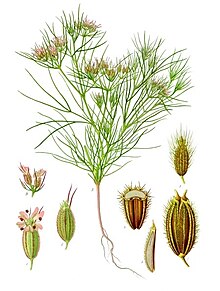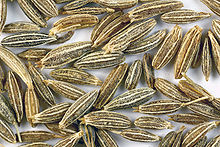Cumin
| Cumin | |
|---|---|

| |
| Scientific classification | |
| Kingdom: | |
| (unranked): | |
| (unranked): | |
| (unranked): | |
| Order: | |
| Family: | |
| Genus: | |
| Species: | C. cyminum
|
| Binomial name | |
| Cuminum cyminum | |
Cumin (/[invalid input: 'icon']ˈkjuːm[invalid input: 'ɨ']n/ or UK: /ˈkʌm[invalid input: 'ɨ']n/, US: /ˈkuːm[invalid input: 'ɨ']n/; sometimes spelled cummin; Cuminum cyminum) is a flowering plant in the family Apiaceae, native from the east Mediterranean to India. Its seeds, in both whole and ground form, are used in the cuisines of many different cultures.
Etymology
The English "cumin" derives from the Old English cymen (or Old French cumin), from Latin cuminum,[2] which is the latinisation of the Greek κύμινον (kuminon),[3] cognate with Hebrew kammon and Arabic kammun.[4] Forms of this word are attested in several ancient Semitic languages, including kamūnu in Akkadian.[5] The ultimate source is the Sumerian word gamun.[6] The earliest attested form of the word κύμινον (kuminon) is the Mycenaean Greek ku-mi-no, written in Linear B syllabic script.[7]
Description
Cumin is the dried seed of the herb Cuminum cyminum, a member of the parsley family. The cumin plant grows to 30–50 cm (0.98–1.64 ft) tall and is harvested by hand. It is an herbaceous annual plant, with a slender branched stem 20–30 cm tall. The leaves are 5–10 cm long, pinnate or bipinnate, thread-like leaflets. The flowers are small, white or pink, and borne in umbels. The fruit is a lateral fusiform or ovoid achene 4–5 mm long, containing a single seed. Cumin seeds resemble caraway seeds, being oblong in shape, longitudinally ridged, and yellow-brown in color, like other members of the Umbelliferae family such as caraway, parsley and dill.
History

Cumin has been in use since ancient times. Seeds excavated at the Syrian site Tell ed-Der have been dated to the second millennium BC. They have also been reported from several New Kingdom levels of ancient Egyptian archaeological sites.[8]
Originally cultivated in Iran and Mediterranean region, cumin is mentioned in the Bible in both the Old Testament (Isaiah 28:27) and the New Testament (Matthew 23:23). It was also known in ancient Greece and Rome. The Greeks kept cumin at the dining table in its own container (much as pepper is frequently kept today), and this practice continues in Morocco. Cumin fell out of favour in Europe, except in Spain and Malta, during the Middle Ages. It was introduced to the Americas by Spanish and Portuguese colonists. There several different types of cumin but the most famous ones are black and green cumin which they both used in Persian cuisine.
It has since returned to favour in parts of Europe. Today, it is mostly grown in Iran, Uzbekistan, Tajikistan, Turkey, Morocco, Egypt, India, Syria, Mexico, and Chile. The plant occurs as a rare casual in the British Isles, mainly in southern England, but the frequency of its occurrence has declined greatly. According to the Botanical Society of the British Isles' most recent Atlas, there has been only one confirmed record since 2000.
Cultivation

Cultivation of cumin requires a long, hot summer of 3–4 months, with daytime temperatures around 30 °C (86 °F); it is drought-tolerant, and is mostly grown in Mediterranean climates. It is grown from seed, sown in spring, and needs fertile, well-drained soil.
Uses
Cumin is the second most popular spice in the world after black pepper.[9][unreliable source?] Cumin seeds are used as a spice for their distinctive aroma, popular in Nepalese, Indian, Pakistani, North African, Middle Eastern, Sri Lankan, Cuban, northern Mexican cuisines, central Asian Uzbek cuisine, and the western Chinese cuisines of Sichuan and Xinjiang. Cumin can be found in some Dutch cheeses, such as Leyden cheese, and in some traditional breads from France. It is commonly used in traditional Brazilian cuisine. Cumin can be an ingredient in chili powder (often Texan or Mexican-style), and is found in achiote blends, adobos, sofrito, garam masala, curry powder, and bahaarat.
Cumin can be used ground or as whole seeds. Cumin was also used heavily in ancient Roman cuisine. It helps to add an earthy and warming feeling to cooking, making it a staple in certain stews and soups, as well as curries and chilli.
Nutritional value
| Nutritional value per 100 g (3.5 oz) | |
|---|---|
| Energy | 1,567 kJ (375 kcal) |
44.24 g | |
| Sugars | 2.25 g |
| Dietary fiber | 10.5 g |
22.27 g | |
| Saturated | 1.535 g |
17.81 g | |
| Vitamins | Quantity %DV† |
| Vitamin A equiv. | 7% 64 μg |
| Riboflavin (B2) | 25% 0.327 mg |
| Niacin (B3) | 29% 4.579 mg |
| Vitamin B6 | 26% 0.435 mg |
| Folate (B9) | 3% 10 μg |
| Vitamin B12 | 0% 0 μg |
| Vitamin C | 9% 7.7 mg |
| Vitamin E | 22% 3.33 mg |
| Vitamin K | 5% 5.4 μg |
| Minerals | Quantity %DV† |
| Calcium | 72% 931 mg |
| Iron | 369% 66.36 mg |
| Magnesium | 87% 366 mg |
| Phosphorus | 40% 499 mg |
| Potassium | 60% 1788 mg |
| Sodium | 7% 168 mg |
| Zinc | 44% 4.8 mg |
| Other constituents | Quantity |
| Water | 8.06 g |
| †Percentages estimated using US recommendations for adults,[10] except for potassium, which is estimated based on expert recommendation from the National Academies.[11] | |
Although cumin seeds contain a relatively large percentage of iron, extremely large quantities of cumin would need to be consumed for it to serve as a significant dietary source (see nutrition data).
Confusion with other spices

Cumin is sometimes confused with caraway (Carum carvi), another umbelliferous spice. Cumin is however hotter to the taste, lighter in color, and larger. Many European languages do not distinguish clearly between the two though. Many Slavic and Finno-Ugric languages referring to cumin as "Roman caraway". Examples include Czech: kmín - caraway, římský kmín -cumin; Polish: kminek - caraway, kmin rzymski - cumin; Hungarian: kömény - caraway, római kömény - cumin. Finnish: kumina - caraway, roomankumina - cumin, although sometimes also called juustokumina, cheese caraway. In Swedish and Norwegian, caraway is called kummin while cumin is spiskummin, from the word spise, to eat, while in German, Kümmel stands for caraway and Kreuzkümmel denotes cumin. . In Icelandic, caraway is kúmen, while cumin is kúmín. In Romanian, chimen is caraway, while chimion is cumin, the latter being less known.
The distantly related Bunium persicum and the unrelated Nigella sativa are both sometimes called black cumin (q.v.).
Aroma profile
Cumin's distinctive flavour and strong, warm aroma is due to its essential oil content. Its main constituent and important aroma compound is cuminaldehyde (4-isopropylbenzaldehyde). Important aroma compounds of toasted cumin are the substituted pyrazines, 2-ethoxy-3-isopropylpyrazine, 2-methoxy-3-sec-butylpyrazine, and 2-methoxy-3-methylpyrazine.
This section needs expansion. You can help by adding to it. (July 2009) |
Images
-
Dry, whole cumin fruit (or seed)
-
Whole cumin seeds and ground cumin
-
Commercially packaged whole and ground cumin seeds
-
Close up of dried cumin seeds
Notes and references
- ^ "Cuminum cyminum information from NPGS/GRIN". www.ars-grin.gov. Retrieved 13 March 2008.
- ^ cuminum, Charlton T. Lewis, Charles Short, A Latin Dictionary, on Perseus Digital Library
- ^ κύμινον, known as saunf or سونف in Pakistan. Henry George Liddell, Robert Scott, A Greek-English Lexicon, on Perseus Digital Library
- ^ cumin, Online Etymology Dictionary
- ^ "Kamūnu." premiumwanadoo.com.
- ^ Anton Deimel, Orientalia Old Series 13 (1924) 330.
- ^ Palaeolexicon, Word study tool of ancient languages
- ^ Daniel Zohary and Maria Hopf, Domestication of plants in the Old World, third edition (Oxford: University Press, 2000), p. 206
- ^ http://www.foodreference.com/html/fcumin.html
- ^ United States Food and Drug Administration (2024). "Daily Value on the Nutrition and Supplement Facts Labels". Retrieved 28 March 2024.
- ^ National Academies of Sciences, Engineering, and Medicine; Health and Medicine Division; Food and Nutrition Board; Committee to Review the Dietary Reference Intakes for Sodium and Potassium (2019). Oria, Maria; Harrison, Meghan; Stallings, Virginia A. (eds.). Dietary Reference Intakes for Sodium and Potassium. The National Academies Collection: Reports funded by National Institutes of Health. Washington, DC: National Academies Press (US). ISBN 978-0-309-48834-1. PMID 30844154.
- ^ a b c Li, Rong (2004). "Chemical composition of the essential oil of Cuminum cyminum L. from China". Flavour and Fragrance Journal. 19 (4): 311–313. doi:10.1002/ffj.1302.
{{cite journal}}:|access-date=requires|url=(help); Unknown parameter|coauthors=ignored (|author=suggested) (help) - ^ a b Wang, Lu; Wang, Z; Zhang, H; Li, X; Zhang, H; et al. (2009). "Ultrasonic nebulization extraction coupled with headspace single drop microextraction and gas chromatography–mass spectrometry for analysis of the essential oil in Cuminum cyminum L.". Analytica Chimica Acta. 647 (1): 72–77. doi:10.1016/j.aca.2009.05.030. PMID 19576388.
{{cite journal}}:|access-date=requires|url=(help); Cite has empty unknown parameter:|coauthors=(help); Explicit use of et al. in:|first=(help) - ^ a b Iacobellis, Nicola S.; Lo Cantore, P; Capasso, F; Senatore, F; et al. (2005). "Antibacterial Activity of Cuminum cyminum L. and Carum carvi L. Essential Oils". Journal of Agricultural and Food Chemistry. 53 (1): 57–61. doi:10.1021/jf0487351. PMID 15631509.
{{cite journal}}:|access-date=requires|url=(help); Cite has empty unknown parameter:|coauthors=(help); Explicit use of et al. in:|first=(help)



